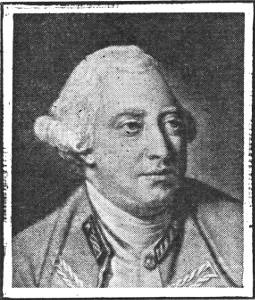
GEORGE THE THIRD
THE STORY OF AMERICA IN PICTURES
By ALBERT BUSHNELL HART
Professor of Government, Harvard University

GEORGE THE THIRD

GEORGE WASHINGTON
THE MENTOR
DECEMBER 8, 1913
SERIAL No. 43
DEPARTMENT OF HISTORY
MENTOR GRAVURES
BATTLE OF LEXINGTON · BATTLE OF BUNKER HILL · WASHINGTON CROSSING THE DELAWARE · SIGNING OF THE DECLARATION OF INDEPENDENCE · “I HAVE NOT YET BEGUN TO FIGHT”—JOHN PAUL JONES · THE BIRTH OF THE FLAG
Words wear out after using them a thousand or a million times. “Liberty,” “The Constitution,” “The People’s Government,”—people take those terms into their minds nowadays as they take a chocolate cream, without stopping to think of its contents. So with “Revolution.” When we hear the word we feel a pleased sensation of a good, great, glorious time, intended by Providence to prepare the way for our various patriotic organizations. The Revolution? Why, yes, that was when our forefathers tied the first hard knot in the British lion’s tail! All the people were patriots, and all the patriots were as wise as college professors, and as brave as Albanians, and as great as a president. All the statesmen wore silk stockings and red velvet suits and powdered wigs. All the ladies were lovely, and spurned the offers of marriage made by British generals.

GENERAL NATHANAEL GREENE
His courageous work in the South greatly helped the American cause. (From painting in possession of the Historical Society of Pennsylvania.)
What is a revolution but an overturning, a spinning of the wheel, left to right, and bottom come uppermost? Likewise, since the right believes itself right, and the top is sure that the world exists in order that it may be the top, most revolutions mean force, arms, big guns booming, troops marching, bullets flying, heads cut off with axes or caught in a hangman’s noose; also arms and legs cut off, and the ground soaked with a crimson fluid. “You can’t make an omelet without breaking some eggs,” and in a revolution there is bound to be breakage of heads and hearts, and banks and constitutions.
We know that the American Revolution was a military contest, because the pictures in our first textbook of American history show General George Washington, in buff and blue, leading his Continentals up to within sixteen feet and eight inches of General Howe, in a magnificent red coat laced with gold, in vain trying to rally battalions of craven Hessians wearing highly inconvenient bearskin caps.

THE BUNKER HILL MONUMENT
Commanding officers of opposing armies are not really so intimate as that; but Americans are justified in immense pride over the military success of the Revolution. The simple fact was that three million people, of whom about a fourth were negro slaves, put up a fight against a mother country having four times their population. They began without a single professional officer, except the traitor Charles Lee; and with only a thousand or two men who had not seen military service except militia training day, and desultory frontier warfare with French and Indians. They had not one ship of war, not a factory of arms. Yet they attacked the great British empire,—though it was flanked right and left by the lion and the unicorn, trained by two centuries of European wars, thousands of troops under arms, officers successful in other fields,—and they sailed into the greatest naval power on the sea.
So far as power and prestige and experience decide wars in advance, the Revolution was due to be snuffed out at the end of 1776; Benjamin Franklin was destined to be hanged, George Washington to be immured for life in a gloomy dungeon, dressed in a ball and chain. Were not the English everywhere successful? They captured New York, they captured Newport, they captured Philadelphia, they captured Savannah; they were driven away from Charleston by the palmetto forts, but returned and captured Richmond. They beat the Americans at Long Island, at the Brandywine, at Germantown, at Camden. Their cruisers and privateers swept the seas, until Nathaniel Tracy of Newburyport lost ninety of his hundred and twenty vessels. They drove the little American navy from the seas.
Yet in the end they were beaten. It is easy now to criticize the strategy of Washington and Greene and the rest, and to show that by all the laws of war they laid themselves open to defeat. Nothing can alter the stubborn fact that the American militia at Bunker Hill for hours held off a British army and so damaged it that it never took the field again; then the Americans captured Burgoyne’s army at Saratoga in 1777, a humiliation seldom known in British annals. And this victory brought the French alliance, and the aid of Von Steuben the magnificent drill master, of d’Estaing and his fleet, of Rochambeau and his army. With that aid, the Americans beat the second army at Yorktown, and that ended the war. General Cornwallis had to surrender his sword to an officer whom a few months before the British had addressed as “George Washington, Esq., etc., etc.”

SURRENDER OF BURGOYNE AT SARATOGA
This picture, from a painting by Trumbull, the famous American artist, shows the surrender of the English general John Burgoyne to the Americans at Saratoga, New York, on October 17, 1777.
In one way the Americans were too successful. Beginning with raw militia, ill-equipped, worse disciplined, the Americans made an army that beat the British. General Washington never ceased to implore Congress and the states to give him a better system for a real national army. Half the men and a fourth of the money expended would have done the job just as well, if the advice of Washington and other experts had been followed.

SURRENDER OF CORNWALLIS
The British general, Lord Cornwallis, surrendered to Washington at Yorktown, Virginia, on October 19, 1781. The victory virtually decided the Revolution in favor of the Americans.
On the sea also the Americans began a great career of naval success; or, rather, they repeated the methods of earlier wars by sending out a hornets’ nest of privateers, christened with such gallant and suggestive names as The Charming Peggy, The Fair Lady, The American Revenue, The Black Joke, The Fair America, The Scotch Irish, The Skunk, The Nimble Shilling, and The King Tamer. If they did not tame George III, they did tame the British merchant and his representatives in Parliament; for American privateers in the course of the war captured about seven hundred British merchantmen.
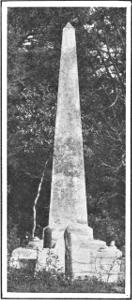
SURRENDER MONUMENT YORKTOWN, VIRGINIA

GENERAL LORD CORNWALLIS
And then there was the American navy; or rather John Paul Jones, for in him the navy was concentrated. It was a painful surprise to the British to have the royal frigate Serapis taken in 1779 by the Bonhomme (Bo-nom) Richard, a condemned merchant ship hastily fitted out in France. Jones is already a sort of mythical figure, partly because of Buell’s imaginary so-called biography; but he is the naval father of Hull and Porter, and the grandfather of Farragut and another Porter, and the great-grandfather of Sampson and Dewey.
A revolutionary overturning came whenever the Union Jack was hauled down and the Stars and Stripes hauled up. But the revolutionary army was not the Revolution: it was like the line in a football match, desperately holding back the other line while the backs get into play. The real Revolution was an overturning of governments, and charters, and political power. The revolving wheel whirled the old colonies out of existence, and cunningly framed and polished new state governments. The Revolution turned the British empire down, and pushed the United States of America up. The Revolution rolled to the bottom of the wheel Governor Gage of Massachusetts, and Governor Tryon of North Carolina, and Governor Dunmore of Virginia; and up to the top revolved Patrick Henry, and Benjamin Franklin, and John Adams. The Revolution was like a religious conversion: it set the American people out of their old ways, and into a new upward path.
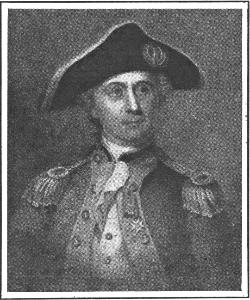
JOHN PAUL JONES
Commander of the first American navy. From the portrait by C. W. Peale.
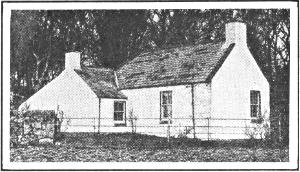
BIRTHPLACE OF JOHN PAUL JONES
John Paul Jones, the “founder of the American navy,” was born in this cottage at Kirkbean, in Scotland, in 1747. He died in Paris in 1792.
All that seems natural to us; for we have been brought up on the tyranny of George III, and the misgovernment and plunder of the colonies by the British government. We realize the bad state of things much better than did the Americans at the beginning of the Revolution. In truth the colonies were freer from harsh and arbitrary government than England, Scotland, and Wales, to say nothing of what was then the separate kingdom of Ireland. Every colony had its local assembly: not a single English county had one. In every colony any freeman who had the necessary pluck and health could acquire land and become a voter: in England not a twentieth part of the adult men could vote. The colonists laid their own taxes and expended them for their own purposes: Englishmen paid taxes levied by a Parliament over which only a few of them had control.
Apparently the main cause of the Revolution was that the colonists could do so much for themselves that there was no reason why they should not do substantially everything for themselves. They had a personal attachment for England, the king, and the English system of government, very like that now felt by the Canadians, and would have been quite satisfied with the degree of self government that England has since freely given to Canada. John Adams says, “That there existed a general desire of independence of the Crown in any part of America before the Revolution, is as far from the truth as the zenith is from the nadir.”

OLD BELFRY, LEXINGTON MASSACHUSETTS
From this belfry was rung out the alarm on the morning of April 19, 1775, calling the minute men to assemble on the common.
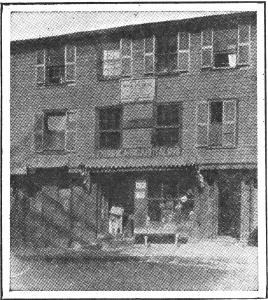
PAUL REVERE’S HOME IN BOSTON
The tablet that may be seen between the second and third stories of the house was placed there by the Paul Revere Chapter of the Daughters of the American Revolution.

PAUL REVERE
From the painting by the famous American artist, Gilbert Stuart.
Then why revolt, especially when above a third of the thinking people in America were opposed to the Revolution, and had to be driven out or silenced? To the original grievances of the Revolution was added a stupid John Bull obstinacy, concentrated in George III, but shared by a good part of the British nation. These mistakes made by England are a fine example of what comes to a country that falls into the hands of what are called the “Interests”; for Parliament was really nothing but a combine of great titled families, who took in some representatives of the cities and the merchant class. One of the best results of the Revolution was that it shook up the British aristocracy; and the best proof that the Revolution was right is the admission of Lord North, when the war was all over, that it had been a great mistake, but that the nation had made it, and not simply the prime minister.
The Revolution was worth all the blood and treasure that it cost, because it lighted a new torch of popular government. There had been plenty of government of the people in ancient and medieval times; but at the epoch of the American Revolution the formerly democratic Swiss and Dutch, and the free citizens of the German and French and Spanish cities, had lost faith in themselves. It was fashionable to revere Demosthenes and Cato and Brutus and the Populus Romanus; but real republican government had about ceased on the earth when the new constellation of the United States appeared on the horizon.
The colonies had very tidy little governments, schools of politics, in which the speaker of the assembly was commonly the leader of a healthy opposition to the governor; and on that foundation they built tidy little state governments, which showed the prevalent belief that governors were dangerous creatures who ought to have as little power as possible; while legislatures were a reflection of the people’s will which could not err. The wheel of revolution has twirled backward in our day; for we make governors and presidents great political leaders, and set our legislators on a one-legged race against the initiative and referendum. In the midst of the confusion of the Revolution, when town after town was picked up by the British, and nobody knew whether the Revolution would win out, it is wonderful how well the state governments worked, and how successful they were in putting on record the great principle of the two kinds of law,—fundamental or constitutional law, and statute law.
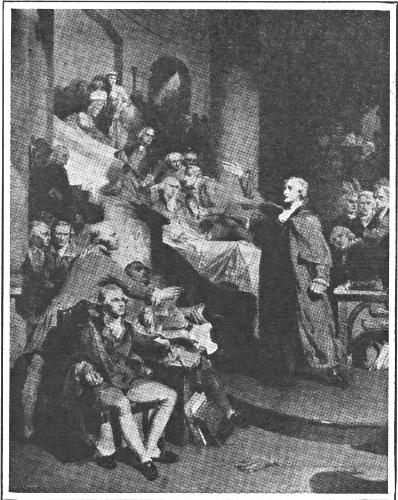
PATRICK HENRY ADDRESSING THE VIRGINIA ASSEMBLY IN 1765.
He is famous for his speech supporting the resolutions to resist the Stamp Act. At one point he exclaimed, “Caesar had his Brutus, Charles the First his Cromwell, and George the Third”—“Treason! treason!” shouted the Speaker of the Assembly, “Treason! treason!” shouted the members—“and,” Henry continued, “George the Third may profit by their example. If this be treason, make the most of it!”
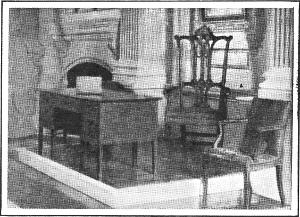
THE CHAIR AND TABLE USED AT THE SIGNING OF THE DECLARATION OF INDEPENDENCE
The finest work of the Revolution was the making of a national government; for which the army and the navy were in part responsible, because a central national power was all that could save the army from capture and the navy from destruction. The Continental Congress became a government before it knew it, authorizing an army and navy, borrowing money, issuing many times more paper notes than it could ever redeem, appointing George Washington commander in chief of the Continental forces, sending ambassadors to foreign countries.
Were men greater on the average then than now? Would Speaker Clark and Senator Lodge of Massachusetts, and Senator Beveridge bulk as big as Patrick Henry and Sam Adams and John Dickinson, if revolution broke out now? “These are the times that try men’s souls,” said Tom Paine, and it was also a time that made men’s souls! The one indispensable man in the Revolution was George Washington; for there was no other in the colonies who was so central, so immovable, a force. But the Revolution would also have failed but for Benjamin Franklin, and Thomas Jefferson, and the other civilians who built up the new government.

BENJAMIN FRANKLIN

THOMAS JEFFERSON

THE SIGNING OF THE DECLARATION OF INDEPENDENCE
From the painting by John Trumbull.

OLD STATE HOUSE IN BOSTON
A crowd listening to the reading of the Declaration of Independence.
And they framed the Declaration of Independence! They framed it; but Thomas Jefferson wrote it. He was bent on proving that the Revolution was right. And, having taken an unpaid brief for his country, he found twenty-seven good reasons for independence, even at the cost of a bloody revolution. Those reasons are not the Declaration: the real pith of that splendidly written document is the brief statement of “self evident truths”; among them “that all men are created equal, that they are endowed by their Creator with certain unalienable Rights, that among these are Life, Liberty and the pursuit of Happiness, that to secure these rights, Governments are instituted among Men, deriving their just powers from the consent of the governed.” Some of the states made much longer and fuller statements of the same kind; but this is the bedrock of popular government in America. Time cannot tarnish, use cannot diminish, age cannot weaken, this splendid thought that God Almighty sends His children into the world with equal political rights; that every human being has an interest in that mutual understanding with other human beings called society and government.

SAMUEL ADAMS
From the painting by the early American artist, J. S. Copley.
When Rip Van Winkle came back home he found a new set of neighbors who scoffed at good King George. The Americans lived in a changed world. In the South most of the political leaders who were not Englishmen took the patriots’ side,—the Randolphs, and the Peytons, and the Carrolls, and the Rutledges, and the Pinckneys, and the Haynes,—and when the war was over the wheel had revolved under them, but left them still at the top. In the North there was a greater change,—Sam Adams, the untitled leader of the Boston town meeting, became leader of Massachusetts; John Hancock, the merchant accused of smuggling, was governor; John Adams, the struggling lawyer, was minister to England. Where were the rich and fashionable people who lived in the fine colonial mansions and drank too much Madeira? Hundreds of them gone, exiled, driven forth, farming in the eastern townships of Canada, waiting in the antechambers of the great in London.

PARSON CLARK’S HOUSE, LEXINGTON
Here Samuel Adams and John Hancock were sleeping when aroused by Paul Revere on his famous ride on April 19, 1775.

JOHN HANCOCK’S HOUSE IN BOSTON
Interesting not only in its historic associations, but as an attractive example of colonial architecture.
That was a revolution that reached the wives and daughters, and the handsome sons who inherited their fathers’ silken suits and had expected to inherit their dignities. It took the Americans thirty years to find out how great a revolution they had undergone in business; for when the war was over they had an unpatriotic hankering for the broadcloths and kerseymeres of old England. For their women folk, dealers still bought calimancos, and paduasoys, and oznabrig linens, and India muslins, through reliable English houses. Again Great Britain made the mistake of undervaluing the Americans; and when they became independent told them to be independent—and suffer for it. Now that the United States of America was a separate nation, let it keep its vessels out of the trade with the former sister colonies! It took long years to open up other avenues of trade.
Within the military and civic Revolution arose another territorial revolution. When in 1778 George Rogers Clark with his few score frontiersmen slipped down the Ohio River and picked up the little British towns of Kaskaskia, Cahokia, and Vincennes, he was blazing the trail into the West, and opening that vast country to millions of Americans still to be born or adopted, till they would in the end rule the republic. Because of Rogers Clark, or rather of the westward vision of the great men of that time, Great Britain gave up the Northwest, and then yielded the Southwest. With all its boldness and courage, the Revolution did not make a complete nation: to become a world power, it was necessary to cross the mountains and bind the Mississippi to the sea. And the man of that time, who was at the same time eastern and western, who fought the French and took up lands and planned roads and canals beyond the mountains, was George Washington, the greatest soldier, best statesman, and most clear-sighted business man of the Revolution.

GEORGE ROGERS CLARK
An American general who in 1778 captured Vincennes from the British. It was soon recaptured; but Clark took it again after a terrible march across country in midwinter. He then conquered all the country near the Wabash and Illinois rivers.

MERIWETHER LEWIS
Companion of William Clark in his western explorations.
SUPPLEMENTARY READING.—“American Revolution,” Claude H. Van Tyne; “American Revolution,” John Fiske; “American Revolution” (3 vols.), George Otto Trevelyan; “Struggle for American Independence” (2 vols.), S. G. Fisher; “George Washington” (5 vols.), John Marshall; “American Statesmen” series (16 vols.); “Literary History of the American Revolution” (2 vols.), Moses Coit Tyler; “Paul Jones,” Norman Hapgood; “Letters and Memoirs,” Madame Rediesel; “The Spy,” James Fenimore Cooper; “Hugh Wynne,” S. Weir Mitchell; “The Partisan,” William Gilmore Simms; “Alice of Old Vincennes,” James Maurice Thompson.
THE MENTOR
ISSUED SEMI-MONTHLY BY
The Mentor Association, Inc.
381 Fourth Ave., New York, N. Y.
Volume 1 Number 43
ANNUAL SUBSCRIPTION, FOUR DOLLARS. SINGLE COPIES TWENTY CENTS, FOREIGN POSTAGE, 75 CENTS EXTRA. CANADIAN POSTAGE, 50 CENTS EXTRA. ENTERED AT THE POST OFFICE AT NEW YORK, N. Y., AS SECOND-CLASS MATTER. COPYRIGHT, 1913, BY THE MENTOR ASSOCIATION, INC., PRESIDENT AND TREASURER, R. M. DONALDSON; VICE-PRESIDENT, W. M. SANFORD; SECRETARY, L. D. GARDNER.
In the early part of the nineteenth century the United States Government realized the importance of having a record on canvas of the nation’s great historical events, and several painters of that day produced pictures that hold places of honor in our Government buildings. John Trumbull was the foremost of these painters.
There has been a demand for several years for new historic paintings. The feeling exists that the painters of one hundred years ago could not have the perspective to portray the Revolution correctly, no more than a historian of the same period could write its history. The time has come for modern artists in American historic art. The World’s Fair at Chicago gave an impetus to the work, especially in decorative form. As a result, public buildings erected within the past twenty years show many interesting and distinguished examples of historic art in mural decorations, by such artists as Blashfield, Kenyon Cox, C. Y. Turner, and others. There is a demand now from many sources—from galleries, Federal and state governments, and from schools—for historical pictures which shall be true and shall also be worthy examples of modern work.
This number of The Mentor contains four distinguished examples of modern historical art. Three of them are the work of Mr. Henry Mosler, and were painted within the past five years.
Mr. Mosler has been known as an artist of great distinction for a long time. As early as 1874 he won a medal at the Royal Academy of Munich, and he won the Thomas B. Clarke prize in the National Academy of Design, New York, in 1896. Mr. Mosler, therefore, brought the ripe powers of a master painter to the work, and he has produced four paintings of great art value and historic importance.
The first picture, which appeared four years ago, is entitled “Ring, Ring, for Liberty,” and represents, with great strength and vigor, the old bell ringer in the cupola of Independence Hall, who sounded the note of liberty in July, 1776. Three years ago Mr. Mosler finished his painting of Betsy Ross and her companions making the first flag, which is reproduced in this number of The Mentor. Mr. Mosler based his work on careful sketches made in the Betsy Ross house on Arch Street, Philadelphia. Our readers will surely feel the grace and charm as well as the vital interest of this picture.
Many have said that our country needed a new painting of “Washington Crossing the Delaware.” The familiar composition, by Leutze, is regarded as stiff and constrained and as lacking a sense of reality. Mr. Mosler’s picture gives a true and spirited conception of the event, based on historical study and on sketches made in the winter time at the point of the Delaware where Washington crossed. The painting of Paul Jones is a vivid dramatic presentment of a historical subject that has never heretofore been pictured in an adequate manner.
Another interesting picture in this group is the “Signing of the Declaration of Independence,” by Miss Sarah Ball Dodson. The actual life and spirit of the scenes in Independence Hall during July, 1776, have not been fully realized by other artists. Miss Dodson’s picture is a striking presentment of the scene, distinguished not only for its art value but for its truth. Each figure is an actual portrait and takes an earnest, living part in the composition. Miss Dodson was a native of Philadelphia, and knew her subject at first hand. Her death some years ago was a distinct loss to American art.

BATTLE OF LEXINGTON
ONE
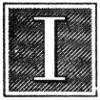
It was a little after midnight on April 19, 1775. In the little village of Lexington, Massachusetts, not far from Boston, all was quiet. The townspeople were sleeping soundly. Suddenly there was the clatter of galloping hoofs, and a horseman, leaping from the saddle before the first house, knocked on its door and shouted, “The British are coming!” That man was Paul Revere, and having roused the village he rode quickly on his way toward Concord.
Lexington, which had been so still a little while before, was now a scene of busy activity. Church bells were ringing, and cannons were booming to warn all the surrounding country. The minutemen were cleaning and loading their muskets; while the women filled powder horns. Soon everything was ready, and the little band of seventy minutemen of Lexington, under command of Captain Jonas Parker, gathered on the village common. There, with grim determination, they formed in line and waited. And there, at daybreak, the force of eight hundred British found them.
“Disperse! Disperse, you rebels!” cried Major Pitcairn, in command of the English. “Down with your arms, and disperse!”
No reply from the minutemen.
“Fire, then!” ordered Pitcairn.
His command was obeyed, and the minutemen answered with “the shot heard round the world.” The Revolution was begun. Eight minutemen were killed, several others were wounded, and the rest were scattered. Then the British advanced toward Concord.
Their object was to capture some arms and ammunition of the Colonists which were stored near Concord. For this reason General Gage had sent them from Boston. Paul Revere had waited until a signal told him that they were crossing the Charles River, and then had made his famous ride to alarm the patriots.
When the British reached Concord they found that the stores had been removed and hidden, and a large force of minutemen waiting for them. The patriots were without uniforms, and were armed with all kinds of weapons, even pitchforks and scythes; but they were determined to protect their homes, and were willing to die if necessary.
Against such brave resistance even the large force of English soldiers could do nothing, and after a few volleys they began a retreat toward Boston. But now the whole country was aroused. The retreating soldiers were fired upon all along the road. Shots came with deadly aim from behind fences, stone walls, and trees.
At last reinforcements came to the English. Their retreat became less of a rout, and they finally reached Charlestown, and from there crossed over to Boston the next morning. They lost 273 men; while the Americans lost 103. The Colonists had won the first encounter in the Revolution.
The battle of Lexington and Concord stirred all thirteen colonies to action. Everywhere there was unanimous determination to resist British opposition. There could be no going back now. Blood had been shed, and the Revolution had begun.
PREPARED BY THE EDITORIAL STAFF OF THE MENTOR ASSOCIATION
ILLUSTRATION FOR THE MENTOR. VOL. 1, No. 43. SERIAL No. 43
COPYRIGHT, 1913, BY THE MENTOR ASSOCIATION, INC.

BATTLE OF BUNKER HILL
PAINTING BY JOHN TRUMBULL
TWO

After the battle of Lexington and Concord, England saw that the resistance of the Colonists was determined, and sent reinforcements to General Gage in Boston. By the end of May, 1775, he had 10,000 trained soldiers under his command. The American force besieging him amounted to about 16,000 men, undisciplined, but brave. The British were virtually held prisoners in Boston.
General Gage therefore decided to sally out on the night of June 18 and capture Bunker Hill near Charlestown. But first he proclaimed martial law and pardon for all those who would lay down their arms and return home, except Samuel Adams and John Hancock. None of the courageous patriots took advantage of his offer.
The Americans discovered Gage’s plans, and decided to beat him to it. So on the evening of June 16 Colonel William Prescott with 1,000 men was ordered to march to Bunker Hill and fortify it. But when they got there it was decided that Breeds Hill, much nearer Boston, would give a better command of the town and shipping. Under Prescott and General Israel Putnam the colonial soldiers worked all night building a redoubt about eight rods square.
When the British sentinels looked up through the mist the next morning (June 17, 1775) they rubbed their eyes in astonishment at sight of the fortifications. The guns from the vessels in the Charles River immediately opened fire; but the Colonists kept steadily at work. At last the redoubt was finished, and the tools were sent to Bunker Hill.
But by this time General Gage had ordered an attack on Breeds Hill. Three thousand picked soldiers landed at the eastern base of the hill, and a little after three o’clock in the afternoon began their advance. The tired Americans, who had been working all night at the intrenchments, expected to be relieved by others; but the reinforcements did not come. Nevertheless, they did not falter for an instant. Steadily up the hill came the level ranks of the Redcoats.
“Wait till you can see the whites of their eyes!” was the order.
Nearer and nearer came the British. Still not a movement from the redoubt. It was believed that the Colonials had fled.
But no! Suddenly, at the word “Fire!” fifteen hundred of the concealed patriots rose and poured such a deadly rain of bullets upon the English that whole companies were wiped out. Pellmell down the slope ran the terrified British; while a shout of triumph rose from the redoubt. But at the bottom their officers beat them back into line, and the attack was begun once more. Charlestown was set afire by Gage’s orders. This infuriated the Americans, and again the English were driven back down the hill in disorder.
Then came the third attack. The ammunition of the Colonists was giving out. Only a few more shots remained, and after this the Americans retreated in good order across Charlestown Neck. The British had won a technical victory; but at terrible cost—1,054 killed and wounded out of 2,500 engaged. The American loss was 450, among this number the brave General Warren.
This battle, which took place on Breeds Hill, has always been known as the battle of Bunker Hill. It lasted two hours.
The cornerstone of the Bunker Hill Monument was laid on Breeds Hill on the fiftieth anniversary of the battle, June 17, 1825. Daniel Webster’s speech on this occasion is well known as a great piece of oratory. The monument is an obelisk, 221 feet high and 30 feet square at the base.
PREPARED BY THE EDITORIAL STAFF OF THE MENTOR ASSOCIATION
ILLUSTRATION FOR THE MENTOR. VOL. 1, No. 43. SERIAL No. 43
COPYRIGHT, 1913, BY THE MENTOR ASSOCIATION, INC.

© The Knapp Co., Inc., N. Y.
WASHINGTON CROSSING THE DELAWARE
PAINTING BY HENRY MOSLER
THREE

In December, 1776, the hopes of the Colonists were at the lowest ebb. The American cause was almost lost. It was one of the most critical situations in the whole Revolution. The British occupied New York and all New Jersey, and so confident were they of success that troops were being sent back to England. One false move would plunge the colonies into immediate defeat. It was George Washington who saved the day in this dark time.
Colonel Rall was at Trenton, New Jersey, with 1,500 Hessians, soldiers whom England had hired from Germany. The American army under Washington, beaten and discouraged, but always ready and able to fight, was on the other side of the Delaware, at a point a few miles above Trenton.
Rall despised the Colonials. He did not plant a single cannon. “What need of intrenchments?” he said. “Let the rebels come. We will at them with the bayonet.”
Washington planned to attack Trenton secretly on Christmas night. He knew that, according to their custom, the Hessians would celebrate Christmas Day with a long carousal, and figured that they would be in no condition to put up a strong resistance in the cold, gray dawn of December 26. So, on the evening of December 25, Washington prepared to cross the Delaware above Trenton with about 2,000 men.
General Gates was to lead 10,000 from below Trenton; but, jealous of Washington, he refused to obey, and rode to Baltimore to intrigue in Congress for General Schuyler’s place in the north.
Washington proposed to cross the Delaware at McConkey’s Ferry, now Taylorsville. It was a terrible journey. The river was full of floating ice, the current was swift, and about midnight a fierce storm of snow and sleet set in. At last, at four A. M., all the men and guns stood on the Jersey shore.
The army then moved on Trenton as fast as possible in two divisions; but it was broad daylight before it reached the town. There it was discovered by the enemy’s pickets. These fired immediately, and the sound woke Colonel Rall and his officers who were sleeping off their debauch. Rall roused his men, and placing himself at their head gave battle to the Americans. The fight lasted only thirty-five minutes. The Hessians were defeated, and sent flying toward Princeton, and Colonel Rall was mortally wounded.
It was a magnificent victory. One thousand prisoners, 1,200 small arms, six brass field guns, and all the German flags were captured. It is evidence of Washington’s genius that, against overwhelming odds and in the face of every discouragement, he was able to seize such an opportunity to turn the darkness of defeat into the glory of victory. By this bold stroke he so strengthened the cause of the colonies that they were finally able to win out.
The spot where Washington crossed the Delaware is to be perpetuated as a public park. One hundred acres, comprising the tract called “Washington’s Crossing,” have been purchased by action of a commission, and the place will be a permanent memorial of the turning point of the Revolution.
PREPARED BY THE EDITORIAL STAFF OF THE MENTOR ASSOCIATION
ILLUSTRATION FOR THE MENTOR. VOL. 1, No. 43. SERIAL No. 43
COPYRIGHT, 1913, BY THE MENTOR ASSOCIATION, INC.

© The Knapp Co., Inc.
THE SIGNING OF THE DECLARATION OF INDEPENDENCE
PAINTING BY SARAH PAXTON BALL DODSON
FOUR

The Declaration of Independence was a big step for the thirteen brave little colonies to make. Until then they had only been fighting for their rights as colonies of England,—“No taxation without representation.” But after the Declaration of Independence they were battling as a separate country, and if conquered would have had to suffer the fate of rebels and traitors. Congress knew that if America declared itself free from England the aid of France might be hoped for, and this help might decide the whole outcome of the struggle. Besides they had come to a point where they could no longer fight as colonies, but must unite as a separate and independent country.
So on June 7, 1776, a committee was appointed to draw up a Declaration of Independence, which should be prefaced by a clear explanation of the causes that made the colonies adopt it. This committee consisted of Thomas Jefferson, John Adams, Benjamin Franklin, Roger Sherman, and Robert R. Livingston.
After a long discussion the committee decided to have Jefferson make out a copy of the Declaration. His draft was amended slightly, and then reported to Congress as a whole. Here the debate was very warm. Some of the representatives did not want to vote for independence at all. They considered it a too violent move. But at that time the voting was done by colonies, and it soon appeared that the Declaration, much amended, would finally be passed by most of them.
At last, on the Fourth of July, 1776, the Declaration was put up to be voted upon. Pennsylvania voted for independence, a majority of her representatives being favorable, and other colonies soon followed. Delaware had three delegates; but one of them, Caesar Rodney, was absent, over eighty miles from Philadelphia. McKean, one of the two others, burning with a desire to have the vote of his colony recorded in the affirmative, sent a man on a fast horse to bring him back. Ten minutes after receiving McKean’s message Rodney was in the saddle, and, riding all night, he reached Independence Hall in Philadelphia on July 4, just in time to secure the vote of Delaware in favor of independence.
Although it was on July 4, 1776, that the Declaration of Independence was adopted by Congress, it was not signed by all the delegates present at that time; but they all signed before the end of the year.
PREPARED BY THE EDITORIAL STAFF OF THE MENTOR ASSOCIATION
ILLUSTRATION FOR THE MENTOR. VOL. 1, No. 43. SERIAL No. 43
COPYRIGHT, 1913, BY THE MENTOR ASSOCIATION, INC.

© The Knapp Co., Inc.
“I HAVE NOT YET BEGUN TO FIGHT”—JOHN PAUL JONES
PAINTING BY HENRY MOSLER
FIVE

“I have not yet begun to fight!” These words of the famous sea fighter, John Paul Jones, commander of the first American navy, have rung down through the years as typical of the man that spoke them. Pleasant mannered and affable in peace, he was a brave and able fighter when there was a time for it. John Paul Jones was born on July 6, 1747, in Scotland. His father was John Paul, a gardener, and the future admiral took the name Jones about 1773 out of regard for Willie Jones, a wealthy planter and political leader of North Carolina, who had befriended him in his days of poverty.
John Paul went to sea at the age of twelve, and before he was nineteen became first mate of a vessel in the slave trade. But he did not like this kind of work, and after two voyages gave up his position and sailed for England. Both captain and mate of the ship on which he was a passenger died of fever on the way home, and he brought the vessel safely into port. For this he received part of the cargo and a captaincy from the owners. But after making several voyages he suddenly resigned for some unknown reason and went to America, to live in poverty until 1775.
Then when the Revolution began John Paul Jones was made a first lieutenant in the navy by the Continental Congress, on December 22, 1775. He soon became a captain, and did much damage to British shipping. For his good work he was promoted to the rank of commodore and put in command of five ships. He called his flagship the Bonhomme Richard, in honor of Benjamin Franklin, whose “Poor Richard’s Almanac” was very popular at that time.
On August 14, 1779, Jones sailed from France with his squadron of five, accompanied by two French privateers. All but two of his ships soon deserted him; but he kept on his course, and at seven o’clock on the evening of September 23 he sighted the British men-of-war, the Serapis and the Countess of Scarborough. One of his own ships fled immediately; but the fearless American commander attacked the huge Serapis with his little Bonhomme Richard. The Pallas, Jones’ other remaining ship, forced the Countess of Scarborough to surrender; but it seemed at first as if the Richard was doomed. The English commander asked Jones if he wanted to strike his colors; but the courageous American shouted back, “I have not yet begun to fight!” And he proved this by finally compelling the Serapis to surrender after a fierce battle of three hours and a half. It was a glorious victory against overwhelming odds.
The Bonhomme Richard was almost a total wreck. However, Jones moved his men and supplies to the Serapis. Two days later his little flagship sank.
On his return to France Jones was hailed as a great hero. Louis XVI gave him a gold-hilted sword and made him a chevalier of France, and in 1787 Congress awarded him a gold medal in recognition of his services.
In 1788 he entered the Russian navy as a rear admiral; but he was disappointed in his hope of advancement. Owing to the jealousy of Russian officers he was relieved of his command, and in 1790 returned to Paris, where he died on July 18, 1792.
Jones was buried in the St. Louis cemetery for foreign Protestants, where his body was finally discovered over a hundred years later. In July, 1905, a fleet of American warships carried the body to Annapolis, where it now rests in one of the buildings of the naval academy.
PREPARED BY THE EDITORIAL STAFF OF THE MENTOR ASSOCIATION
ILLUSTRATION FOR THE MENTOR. VOL. 1, No. 43. SERIAL No. 43
COPYRIGHT, 1913, BY THE MENTOR ASSOCIATION, INC.

© W. M. Sanford
BIRTH OF THE FLAG
PAINTING BY HENRY MOSLER
SIX

The men of the colonies were the ones who did the actual fighting that won American independence; but the brave women of those times also played their part. It was the courageous confidence and fortitude of their wives and sisters that spurred the men on to final victory. Some of the women had even a more active share than this in the Revolution. Betsy Ross, who made the first flag of the United States, was one of these.
When the colonies first rebelled against the tyrannical rule of Great Britain each was a separate unit in itself. Each had its own system of government, and each its own flag. In no way except by a common feeling against the injustice of the mother country were they bound together. Besides the thirteen different banners of the colonies, there were various regimental ensigns, and all sorts of other flags, with pine trees on them, or the words “Liberty or Death” and “Don’t Tread on Me”; but there was no American national flag.
So, after the Declaration of Independence had stated that the colonies would no longer be bound to England, Congress passed this resolution on June 14, 1777: “Resolved, That the flag of the United States be thirteen stripes, alternate red and white; that the union be thirteen stars, white on a blue field, representing a new constellation.”
About a month previous Congress had appointed General Washington, Robert Morris, and Colonel Ross a committee to get a flag designed and made. These three men went to Betsy Ross in her little upholstery shop on Arch Street, Philadelphia, and asked her to make a flag after the design they showed her. She agreed to do it, and suggested that the stars, which Washington had drawn with six points, be made with five. Her suggestion was carried out. For several years she and her assistants made flags for our government. Her house on Arch Street is still standing.
The United States flag was first blown over a military post at Fort Schuyler, on the present site of Rome, New York. The fort was besieged early in August, 1777. The garrison was without a flag; so it made one according to the design of Congress by cutting up sheets to form the white stripes, and bits of scarlet cloth for the red stripes. The blue ground for the stars was made of pieces of a cloth cloak belonging to Captain Abraham Swartwout.
John Paul Jones is supposed to have been the first to fly the Stars and Stripes over a naval vessel. This ship was the Ranger, to which he was appointed in 1777.
On December 5, 1782, the day when George III acknowledged the independence of the United States, J. S. Copley, the great early American artist, painted the flag in the background of a portrait he was doing of Elkanah Watson.
The flag was not changed until 1795, when two stripes and two stars were added for Vermont and Kentucky. But it was realized that there must be a limit to the stripes, and on April 4, 1818, a recommendation was adopted that the flag be permanently thirteen stripes, representing the thirteen original states, and that a new star be added for each state admitted.
PREPARED BY THE EDITORIAL STAFF OF THE MENTOR ASSOCIATION
ILLUSTRATION FOR THE MENTOR. VOL. 1, No. 43. SERIAL No. 43
COPYRIGHT, 1913, BY THE MENTOR ASSOCIATION, INC.